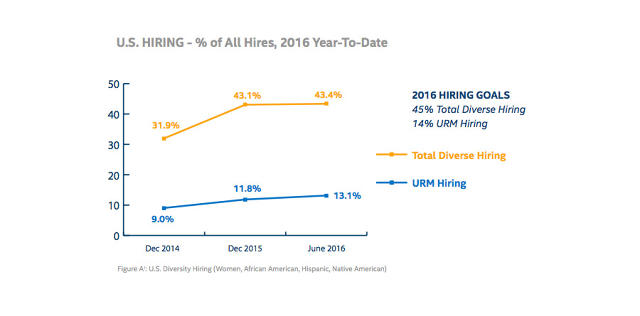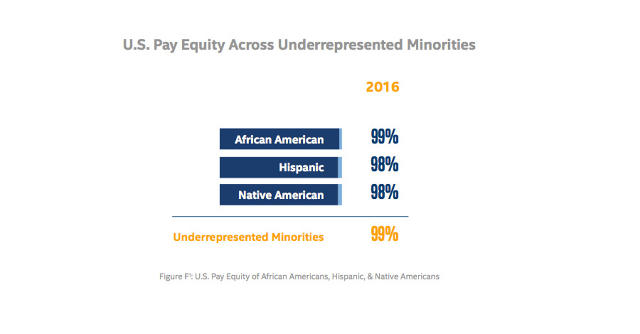Inside Intel’s Progress On Its Bold Diversity Goals
Tech giants in Silicon Valley are known for pursuing big ideas, changing the world through technology and, unfortunately, a fairly extreme lack of diversity.
But at least one company is taking proactive steps in addressing the problem. In January 2015, Intel’s CEO Brian Krzanich made a bold pledge at the annual Consumer Electronics Show in Las Vegas, allocating $300 million to increase diversity within the company and the tech industry at large.
Eighteen months later, the company is making progress on many of its initiatives, while others will require more attention in order to reach the company’s goal of having a workforce that is representative of the U.S.’s working population by 2020.
Intel’s Diversity Progress Report
In the company’s mid-year diversity report, published today, female hires are down slightly from December 2015, from 35.1% to 34.1%. However, 25.4% of Intel employees are female, representing a new record for the company. Underrepresented minority hiring also increased this year, from 11.8% in 2015 to 13.1% in 2016.
“Our mid-year checkpoint shows that we’ve got more work to do,” says Danielle Brown, Intel’s chief diversity and inclusion officer. “This year we have set the goal of 45% diverse [female and underrepresented minority] hires, and we’re not quite there yet, at 43.4%.”

Brown adds that the company is also striving for equal representation among the leadership ranks, as well as equal pay for equal work. Female leadership at the VP level or above grew from 17.6% in December 2015 to 18.7% today, with women representing 42.9% of new leadership hires. Underrepresented minority leadership roles also increased from 6.3% to 6.9% during that time.
“In our last report we did an analysis of gender pay parity, and found that our gender pay parity was at 100%,” says Brown. “Not only have we maintained that gender pay parity at 100%, but we disclosed our numbers across race and ethnicity, and found that we achieved 99% pay equity between our counterpart majority employees and our under-presented minorities, and we have committed to closing that gap and reaching 100% pay parity by the end of the year.”

Tackling The Retention Problem
This past February, as Intel was ushering in a wave of new diversity hires, Fast Company reported that many weren’t sticking around.
African-American workers had a higher exit rate than the rest of the staff, and though the company had recently hired 11 Native American employees, 19 had left the previous year. Brown explains that many of the departures were part of a global restructuring effort that refocused the company on cloud and mobile technologies, but in the first half of 2016, 47 Native American employees, 607 Hispanic employees, and 261 African-American employees left the company, representing a combined 12.3% of the company’s total exits this year. As a point of comparison, 4,590 white employees and 1,552 Asian-American employees left the company during that same period.
“To counter this, we are increasing our rigor and focus on retention and progression of our diverse employees and in 2016, launched programs including a Retention WarmLine to provide additional guidance and counsel to employees who are seeking support and development, or feeling frustrated with the challenges they are facing,” said Brown. “We also completed a Multicultural Progression and Retention study of 15,000 employees that explored the barriers to retaining and progressing our diverse talent. A great deal of work needs to be done inside Intel as well as the broader tech industry to cultivate a fully inclusive environment that welcomes and embraces a broad set of perspectives.”
The Business Case For More Diversity In The Workplace
While Intel has been making incredible strides toward gender and racial equality within its workplace, Brown says there has been some criticism by those who believe that companies should hire the best and brightest, without considering race, gender, or ethnicity.
“I wholly reject the notion that hiring a more diverse workforce means that in any way you’re compromising your standards,” she says. “Not only can you hire an amazingly diverse workforce into the tech industry, but when you hire that amazingly diverse workforce, you find wonderful, well-qualified people.”
Furthermore, as Intel transitions from a PC-centric company toward a broader focus on cloud technologies and smart devices, Brown believes a more diverse workforce will prove advantageous in reaching new markets.
“As we’re entering new markets, calling on new customers, creating new products, we want to make sure our workforce is representative of the consumers that we serve,” she says. “We truly believe that will lead to more growth, more innovation, and better results. Not only is it the right thing to do, but we believe it’s good business.”
In fact, Intel recently commissioned a study called Decoding Diversity, which attempts to quantify the benefits of a more inclusive workforce. The study concludes that diversity leads to higher revenues, profits, and market value.
“In this report, it said that improving ethnic and gender diversity in the U.S. technology workforce could create between $470 billion and $570 billion in new value to the industry, and could add as much as 1.2 to 1.6 percentage points to the national GDP,” explains Brown.
External Initiatives
While Intel has made incredible strides towards diversity within its own workforce it hasn’t stopped there. A number of external programs are helping the company improve the talent pipeline for underrepresented minorities and women in the tech industry, while investing in minority-owned businesses and pursuing a more diverse supplier network.
For example, Intel has invested $25 million over the last 18 months into pipeline development programs that promote STEM education at the high school and university levels, and dedicated another $125 of the Intel Capital Venture Fund over five years toward investing in startups run by women or underrepresented minorities.
“We had committed last year to achieving $1 billion in annual spending with diverse suppliers by the year 2020, and to build up to that run rate this year, we set a goal of reaching $400 million in diverse supplier spending, and we’re on track to achieving that goal,” says Brown.
While the impact these investments have made are yet to be seen, Brown believes that Intel will have a strong impact on increasing diversity and inclusion in what has traditionally been a non-inclusive industry.
Says Brown: “I truly think it’s important to invest in developing the tech industry’s entire ecosystem if you’re really going to change the game.”
CORRECTION: An earlier version of this article stated the company was now 24.5% female. It is actually 25.4%. We regret the error.
Fast Company , Read Full Story
(78)














